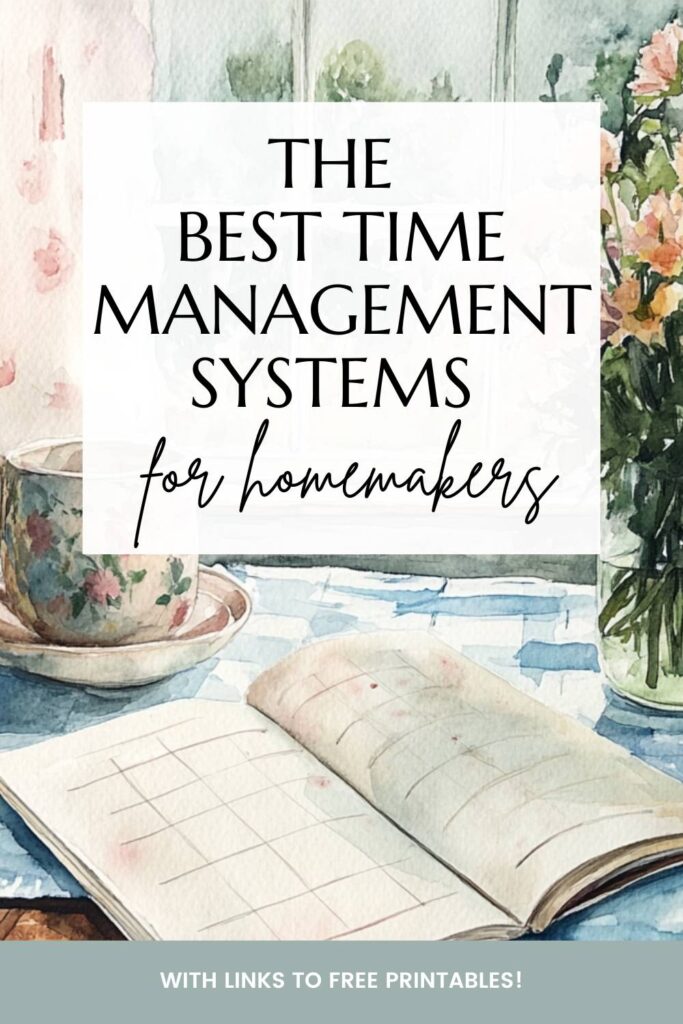Managing Your Home: Simple Time Management for Homemakers
Are you struggling to stay on top of all the tasks and chores in your home, while also prioritizing your faith and family? If you answered yes, a time management system may be just what you’re looking for.

Hey friends! Today we’re discussing one of my favorite topics – planning and home management.
We’re going to be talking time management, specifically from a homemaker’s perspective. Why from a homemakers perspective? Well, because we have a lot going on! Cooking, cleaning, finances, appointments, homeschooling, all while trying to prioritize the relationships within our home.
It’s a lot. And it can leave your head spinning and your body running in 100 different directions every day. Which is why time-management is a must. We’re going to look at three different systems to help you manage your time, as well as the Biblical commands of time management.
And as always, I’ve got some planner recommendations and free printables to help you get started!
Affiliate disclosure: This post may contain affiliate links. As an Amazon Associate this means I will earn a small commission if you choose to purchase through my links. This is at no extra cost to you! Read full disclosure here.
The Importance of Time Management for Homemakers
Why does it matter how you spend your time in your own home? Well, there are a few different reasons that come to mind, but we’re going to focus on the biblical principle, as I see it as the most important motivator for all that we do.

Simply put, our time is a resource given to us by God, just like our money or possessions. We are told specifically to steward our time well in scripture. We don’t want to spend our days pursuing unwise and unfruitful things.
“Look carefully then how you walk, not as unwise but as wise, making the best use of the time, because the days are evil.” Ephesians 5:15
Stewarding our time well goes beyond just being productive. The motivation to have your home function well shouldn’t be just to have it running like a well-oiled machine.
Instead, our motivation should come from a desire to honor God with the time he has given us. Having our home function smoothly by the use of time management systems, allows us to tend to the necessary things within our home (which in itself is an act of service to our families). But it also allows for more freedom in serving and reaching others outside of our home when we aren’t so overwhelmed with our home life.
“But seek first the kingdom of God and his righteousness, and all these things will be added to you.” Matthew 6:33
Time Management Systems for Homemakers
Top 3 Priorities System
First, we’re going to talk about the Top 3 Priorities system. I’ve used this system during seasons of life that my to-do list was overwhelming. I needed a way to consistently chip away at some tasks that had been put on the back burner for just a little too long, and this system was a huge help.

How Priority System Works
The Top 3 Priority System is a minimalist approach to time management that focuses on accomplishing the most critical tasks each day. Each morning, identify three priorities that must be completed before the day ends. This system is particularly beneficial for homemakers who often feel overwhelmed by lengthy to-do lists or who have unpredictable schedules.
The simplicity of this system allows for focus and prevents overcommitting. By concentrating on three essential tasks, you’re more likely to finish what you start and feel a sense of accomplishment.
Who it’s Good For:
This method works especially well for homemakers who prefer a less structured day or need flexibility but want to be diligent in completing their homemaking tasks.
It’s also a great tool for building momentum, as completing three key tasks often leads to tackling additional responsibilities.
Who it’s Not Good For:
If you find that your day is really open ended, with a lot of free time, simply writing down three things to get to may not be exactly what you need. You may need one of the more structed planning systems we will discuss below.
Example of a Top 3 Priority System
A homemaker’s top three priorities for the day might include:
- meal prepping for the week
- calling the doctors office
- cleaning the bathroom
It really just depends on what you have on your to-do list. Speaking of, this little weekly to-do list planner is an excellent resource for using this system. You can keep a running to-do list that you can select your top priorities from each day!
Weekly Rhythm Method
Next, we’re chatting about the weekly rhythm method. This method is super helpful if you’re needing to get a better grasp on the overall flow of your week.
How a Weekly Rhythm Works
The Weekly Rhythm Method involves assigning specific tasks or themes to each day of the week. For example, Monday could be for laundry, Tuesday for deep cleaning, Wednesday for meal planning, and so on. This system provides a predictable routine, making it easier to stay on top of recurring tasks.

Who it’s Good For:
If you find that your days at home are pretty consistent, this system could work for you well. The Weekly Rhythm Method can help eliminate decision fatigue by creating a predefined schedule. You’ll know what to work on each day of the week without having to pick and choose.
Who it’s Not Good For:
However, this system isn’t great for everyone. If you find that your schedule is a bit more volatile (meaning that necessary things come up frequently that require your attention outside the home), this system probably won’t be beneficial. That’s because you need to consistently show up for each days tasks, or else they just get skipped or pushed to another day. This is actually counter-productive and can make you feel behind.
Example of Weekly Rhythm
For instance, a homemaker’s weekly rhythm might look like this:
- Monday: Grocery Shopping, Errands
- Tuesday: Meal Prep Day
- Wednesday: Zone Cleaning Day
- Thursday: Bill Pay Day, Personal Matters
- Friday: Weekend Prep
(Favorite Choice) The Time Block System
If you’ve read any of my posts before, you may already know that time blocking is hands down my favorite way to plan my days. It provides structure but is also able to flex with the day and all that it throws at you.

How Time Blocking Works
The Time Block System involves dividing your day into dedicated blocks of time, each assigned to specific tasks or categories of work. It also allows for you to work in some of your personal needs as a homemaker.
You can have as many blocks in your day as you want, but in general, I would recommend 4-5 pre-determined blocks.
The time blocks you set up will need to be tailored based on your personal commitments. We’re a homeschooling family, so I need a big block during the morning/early afternoon to complete our schooling tasks. However, if your kids go off to school, or you don’t have kids in school at all, the timing of the blocks will look totally different.
I’ll share an example here in just a bit.
Who It’s Good For:
Honestly, I think this system is great for everyone. It is a way to combine so many different tasks and duties into one planning system. Having a flow to your days, designed around your own personal needs, is the best way to cut down on decision fatigue and be highly productive in your home.
Who it’s Not Good For:
Well, I’ve already mentioned that I think time-blocking is the best of the best in time management, so I can’t really think of a reason that it wouldn’t work for someone. But if you’re new to planning and this idea seems overwhelming, (even though I promise it’s not), you can always start with one of the other systems I mentioned.

Examples of Time Blocking
Here’s a sample from my personal week, as a homeschooling family. Keep in mind that you can use these same five blocks, just change the times and what happens in each block based on your needs. Want to start your day earlier or later? Just adjust the early morning block. Don’t homeschool? Swap out the tasks I’ve listed in the working block section for what is considered “work” in your life.
- Early Morning (6 A.M. – 8 A.M.) – Devotional time, write blog posts, get dressed
- Morning (8 A.M. – 10 A.M.) – Breakfast, kids dressed, start laundry, morning time readings
- Working Block (10 A.M. – 4 P.M.) School lessons, household chores or errands depending on the day, to-do list items worked on
- Evening (4 P.M. – 7 P.M.) Dinner prep & cleanup, family time
- Nighttime (7 P.M. – 10 P.M.) Evening commitments, such as practices or church, kids bedtime routines, personal bedtime routine.
Free Schedule Printables to Get You Started
Want to try out one of the planning systems I mentioned here but don’t want to go buy a whole new planner just yet? Try out some of these free calendar printables to get you started!
- Weekly Calendar for Time Blocking
- Weekly Calendar with Time Slots
- Monday through Friday Calendar with Notes Section
- Weekly Household Planner with Daily Chores Checklist

